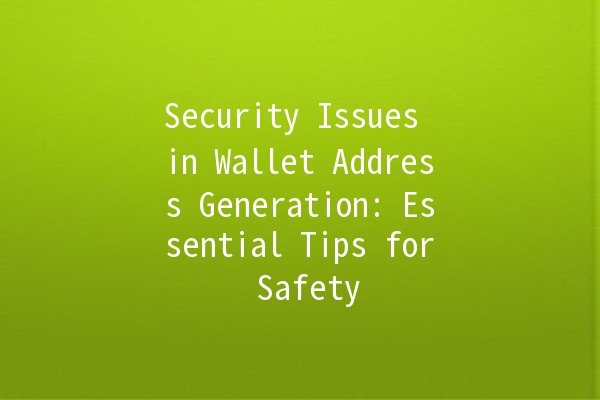




In the rapidly evolving world of cryptocurrencies, the generation of wallet addresses plays a crucial role in ensuring the security of digital assets. However, this process is fraught with potential risks that can lead to the loss of funds if not properly managed. Understanding these security issues and implementing best practices is essential for anyone involved in cryptocurrency transactions. This article delves into the security challenges surrounding wallet address generation and offers practical advice and strategies for safeguarding digital assets.
A wallet address, often resembling a long string of alphanumeric characters, is a unique identifier that allows users to send and receive cryptocurrencies. Each wallet address corresponds to a specific wallet, which holds the user's digital assets. When generating these addresses, understanding how they are created and the associated security implications is vital.
Wallet addresses are typically derived from a public key through cryptographic hashing. The process involves several steps:

While the process seems straightforward, vulnerabilities can arise if not handled properly.
Several security threats can compromise the integrity of wallet addresses and the funds they hold. Let's examine these issues closely.
The security of wallet addresses begins with the private key. If the key generation process is insecure, it can lead to predictable keys, making them easier for attackers to crack.
Usage of weak random number generators can produce predictable private keys. Attackers can employ techniques such as bruteforce attacks to gain access.
Attackers often use social engineering tactics to trick users into revealing their private keys or sending funds to fraudulent addresses.
A user receives an email mimicking a trusted service, asking them to log in through a provided link. The link redirects them to a phishing site that captures their credentials.
Malicious software can compromise devices and capture sensitive information like private keys and seed phrases.
Keyloggers that track keystrokes can record users' inputs when entering their private keys on compromised devices.
Failure to properly back up wallet data can lead to irreversible loss of funds, especially if the wallet software crashes or the device is lost.
Users may neglect to back up their wallet seeds, losing access if the wallet application is uninstalled or the device is damaged.
To safeguard against the security threats outlined above, here are five essential tips for secure wallet address generation.
Description: Ensure that wallet software uses highentropy random number generators for private key generation.
Application Example:
When setting up a wallet, choose a reputable cryptocurrency wallet known for using robust algorithms, such as BIP39 for generating mnemonic phrases.
Description: Utilize 2FA to add an extra layer of security to your wallet and exchanges.
Application Example:
After creating an account on a cryptocurrency exchange, enable 2FA using applications like Google Authenticator or Authy to require a second form of verification when logging in.
Description: Keeping wallet and security software up to date minimizes vulnerabilities.
Application Example:
Regularly check for updates for your wallet software and related security tools. Enable automatic updates where possible.
Description: Avoid public WiFi when accessing your wallet and be cautious of unsolicited communications.
Application Example:
If you need to access your cryptocurrency wallet, only do so over secure and private networks, and verify the source of any communications.
Description: Regularly back up wallet data, including seed phrases, in multiple secure locations.
Application Example:
Write down your recovery seed on paper and store it in a safe place, such as a safe or safety deposit box, and consider using hardware wallets for additional backup options.
A public key is derived from a private key and is used to create wallet addresses. A wallet address is a specific representation of the public key and is what users share to receive funds.
Malware can capture sensitive information like private keys, allowing attackers to access your wallet without authorization. It can also disable security measures you have in place.
Recovery depends on whether you have a backup of your private key or recovery seed phrase. If you do, you can restore access to your funds.
Choose wallets that are opensource and have been extensively reviewed by the community. Look for wallet software that employs industrystandard cryptography and offers robust security features.
Immediately transfer your funds to a new wallet with a secure, newly generated address. Update your security measures and conduct a thorough malware scan on your device.
While you can use the same wallet address multiple times, it's considered best practice to generate a new address for each transaction to enhance privacy and security.
The security of wallet address generation is a complex topic requiring awareness, vigilance, and proactive measures. By understanding the associated risks and implementing effective security practices, users can significantly reduce their vulnerability to attacks. Never underestimate the importance of safeguarding your private keys and sensitive information, as the security of your digital assets depends on it.
This article has provided an indepth examination of the security issues related to wallet address generation and offered actionable tips to enhance protection. By adhering to these recommendations, cryptocurrency users can enjoy a safer experience in their digital transactions.